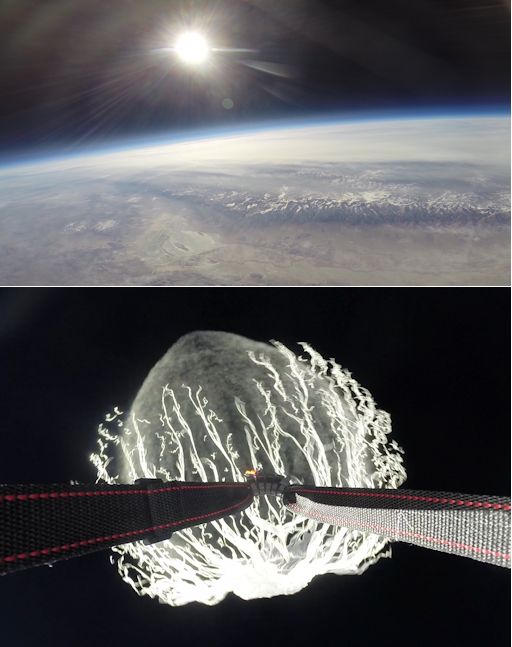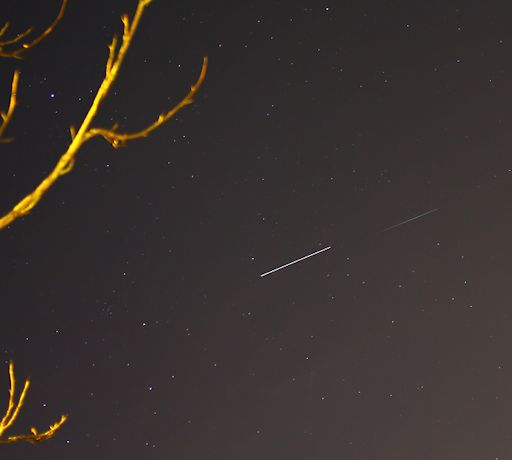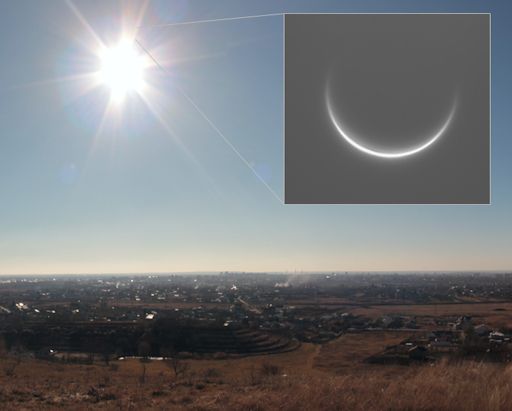SOLAR WIND: Earth is entering a fast stream of solar wind that could spark auroras at high latitudes. NOAA forecasters estimate a 45% chance of geomagnetic storms on Jan. 12th. Aurora alerts: text, voice.
CYGNUS AND THE ISS: This morning, Jan. 12th, a robotic arm on the ISS reached out and snagged Orbital Sciences Corporation's Cygnus supply ship, which reached the ISS on time despite a launch delay last Wednesday caused by stormy space weather. The docking at 8:05 am EST marked the first successful contracted cargo delivery by Orbital Sciences.
Only five hours before the docking, the two spacecraft flew over the Netherlands where veteran satellite observer Marco Langbroek was waiting with his camera to take this picture:
"The Cygnus cargoship was too faint to be seen by the naked eye for most of the pass, but around 5:57:05 UTC it briefly flared to mag +2 and the close duo ISS-Cygnus was suddenly and briefly well visible as a result," says Langbroek. "This picture shows the moment when the Cygnus flared."
Cygnus delivered almost 2800 lbs of equipment and crew supplies to the space station. This includes dozens of new science experiments including 23 designed by students. One newly arrived investigation will study the behavior of ants in microgravity. Another will probe the decreased effectiveness of antibiotics during spaceflight--a possible problem for astronauts on long space journeys. Yet another will explore how different materials burn in microgravity to improve fire safety in future spacecraft. More information is available from NASA.
Realtime Space Weather Photo Gallery
VENUS AT INFERIOR CONJUNCTION: This weekend Venus is at inferior conjunction. That means it is passing almost directly between Earth and the sun. With its nightside facing Earth (almost perfectly), Venus looks like an incredibly slender crescent. On Jan. 11th in Targoviste, Romania, amateur astronomer Maximilian Teodorescu photographed Venus only 5 degrees from the sun:
"Taking extreme care not to point any unfiltered optics at the sun, I started to look for Venus through my 11-inch Celestron telescope," says Teodorescu. "The thin but very large crescent suddenly appeared into the field of view. It was surreal to watch the boiling atmospheric arc of the planet just above the sun in plain day. My wife immortalized the moment by taking a panoramic view from our clear-sky location."
Observing Venus through a telescope can be dangerous. Even a quick inadvertent glimpse of magnified light from the nearby sun can cause serious eye damage. Anthony J. Cook of the Griffith Observatory has some advice for observers: "I have observed Venus at conjunction, but only from within the shadow of a building, or by adding a mask to the front end of the telescope to fully shadow the optics from direct sunlight. This is tricky with a refractor or a catadioptric, because the optics start at the front end of the tube. Here at Griffith Observatory, I rotate the telescope dome to make sure the lens of the telescope is shaded from direct sunlight, even through it means that the lens will be partially blocked when aimed at Venus. With our Newtonian telescope, I add a curved cardboard mask at the front end of the tube to shadow the primary mirror."
Around the world, many people are applying these techniques to photograph Venus as it passes by the sun. Browse the gallery to see their amazing results:
SPACE WEATHER BALLOON UPDATE: The payload of a space weather balloon launched Jan. 8th by the students of Earth to Sky Calculus has been recovered from its landing site in Death Valley National Park. The purpose of the flight was to study a solar radiation storm in progress at the time of the launch. Analyzing the data will take a few days. Meanwhile, here is the view from the stratosphere:

These pictures were taken by a pair of Hero3+ cameras looking out of the payload capsule. The upper frame shows the Sierra Nevada mountain range, unusually brown for this time of year as California endures a historic drought. The lower frame captures the balloon popping at an altitude of approximately 100,000 feet. Click on each frame for a closer look. The landscape shot was made using the Hero3+'s new "superview mode"--a favorite of snowboarders and now, for the first time, balloonists!
Solar wind
speed: 677.8 km/sec
density: 0.9 protons/cm3
explanation | more data
Updated: Today at 2228 UT
X-ray Solar Flares
6-hr max: C1 2034 UT Jan12
24-hr: C6 0005 UT Jan12
explanation | more data
Updated: Today at: 2200 UT
![]()
Daily Sun: 12 Jan 14
Departing sunspot AR1944 has a 'beta-gamma-delta' magnetic field that harbors energy for X-class solar flares. Credit: SDO/HMI




